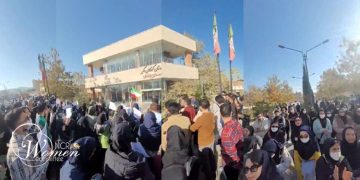In an impressive demonstration of solidarity with the Iranian Resistance and opposition to the clerical regime’s president attending the UN General Assembly, thousands of Iranians gathered outside United Nations headquarters in a rally in New York on Tuesday, September 23, 205.
Participants in the rally in New York protested the presence of the clerical regime’s president at the UN, calling out the regime’s abuses while championing a democratic, secular republic.
They voiced strong backing for the organized Resistance led by NCRI President-elect Maryam Rajavi and her Ten-Point Plan, declaring that the time of dictatorship in Iran—whether under the Shah or the mullahs—has come to an end.
The rally in New York brought together Iranians from across the United States, and young Iranian activists, united in urging recognition of the Iranian people’s right to overthrow tyranny and establish a free Iran.
In a message read to the rally in New York, Maryam Rajavi lauded the perseverance of Iranians who gather annually in New York to protest. She added, “With your powerful presence in front of the United Nations, the world sees that you represent the people of Iran; you are the voice of the Iranian people before the United Nations, not the president of the Supreme Leader.”

Mrs. Rajavi underscored that if the Iranian Resistance had not revealed the regime’s secret nuclear sites 23 years ago—and continued to make 133 disclosures since—the mullahs would have already armed themselves with an atomic bomb and confronted the world with a fait accompli.
She further stressed that the Resistance Units and rebellious youth are the most alert and vigilant fighters in Iran, embodying the nation’s passionate hope for freedom. She concluded, “Our message for Iran’s future is simple: the sovereignty of the people. We want neither a mullah nor a Shah.”

Carla Sands, former U.S. Ambassador to Denmark, highlighted the size of the gathering, telling the crowd that “the Iranian people have been silenced inside their own country. But here, right here, their voices are heard loudly, clearly, and with urgency.” She warned that nearly 1,800 executions had been carried out under the regime’s president Masoud Pezeshkian and added that what the regime fears most is the organized opposition.
She described meeting Maryam Rajavi as inspiring, especially her “elevation of women into the highest ranks of the resistance,” and called the NCRI’s Ten-Point Plan a “roadmap to freedom rooted in equality and justice.”

Linda Chavez, former director of the White House Office of Public Liaison, echoed this message, noting the rally’s impressive turnout and determination. “Thousands of you have come to New York to demand an end to the Khamenei regime,” she said, emphasizing that the true alternative already exists. “During the more than 30 years since, I have gotten to know the leadership of the PMOI/MEK and have happily supported their long struggle for the Iranian people,” she said.
Rejecting any restoration of the monarchy, she said, “The Shah was a murderous dictator. Iran’s future does not lie in giving power to his son, who even boasts of his relationship with the IRGC.” She addressed the rally, saying, “The Iranian people deserve better,” and sent a direct message to President Pezeshkian: “Change is coming.”
Soolmaz Abooali, a faculty member at the Carter School of Peace and Conflict and a 14-time U.S. Karate Champion, stressed that the regime’s repression depends on the Revolutionary Guards. “These crimes are carried out by and under the protection of the IRGC,” she said, adding that the MEK has led an organized resistance for six decades. “Monarchy has no place in Iran’s future. The people won’t accept another form of unelected rule,” she noted.
Sarvie Golestaneh, a design associate at Evolution Architecture, expressed pride in supporting the movement for “freedom, gender equality, and national sovereignty.” She said the regime fears the only democratic solution “led by women” and stressed, “The only way forward is through the voices of the Iranian women. We are marching forward to revolution.”
Setareh Vatan, a licensed psychotherapist in California, pointed to the dangers faced by professionals in Iran. “Those who treat survivors of state violence and protest-related trauma risk being interrogated, harassed, or pressured to reveal patient information,” she said. Referring to Maryam Rajavi’s Ten-Point Plan as a practical democratic framework, she concluded, “This struggle is about dignity, freedom, and life itself. Their fight is our fight. Their freedom is our freedom.”

Michelle Shariati, an Iranian American activist, recounted her father’s imprisonment in the 1980s for distributing MEK leaflets. “It was the bravery of women prisoners that kept them going,” she said. Declaring her own support, she added, “The only movement with the clarity and courage to uproot this regime is the MEK. I stand with the MEK, I stand with the NCRI, and I stand with Maryam Rajavi.”
Hanif Ahadi, the grandson of a victim of the 1988 massacre, vowed to carry forward his grandfather’s legacy. “I stand for a free Iran, where the death penalty is abolished, where men and women are equal, and where clerics do not rule from a throne,” he said. Honoring the women leaders of the Resistance, he added, “I am the grandson of a martyr—but more importantly, I am the grandson of a vision.”
Parsa Aria, a young Iranian American born in Texas, said, “Our generation refuses to accept dictatorship as Iran’s destiny.” He praised the Resistance Units as “heroes of my generation” and declared, “Dictatorship, whether Shah or Supreme Leader, will not stand. Together across borders and generations, we will bring down this regime and build an Iran where freedom prevails.”

Saba Rezaii, an Iranian activist, described the 2022 uprising as a turning point that “illustrated the fragility of a divided regime.” She said women and youth have become “the architects of Iran’s democratic future,” having paid with “body, bones, and all.” Rejecting monarchy as another form of dictatorship, she told the crowd, “Those who call themselves king embody the tyranny and misogyny of yesteryear. Incapable is the head that wears the crown.”
Rezaii endorsed Maryam Rajavi’s Ten-Point Plan as a vision of “a pluralistic, culturally diverse, and religiously open society led by the people.” She urged the world to act: “Enforce the Security Council resolutions. Recognize the Iranian people’s right to choose their own government. No more appeasement.” She closed with a rallying cry: “Forward to revolution! Death to the oppressor, be it the shah or the supreme leader.”
























